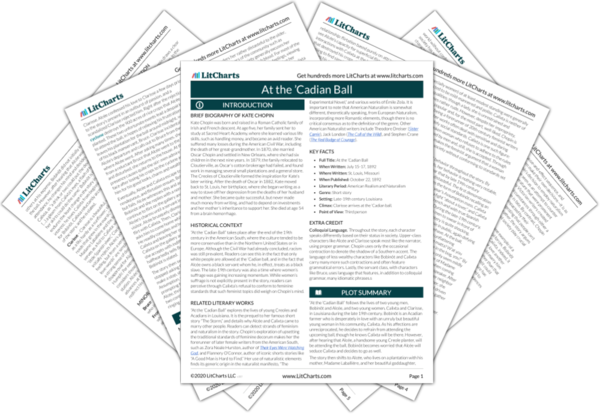Chopin wrote “At the ’Cadian Ball” in 1892, during the end of the Victorian era, in which people placed high value on decorum and good manners. Individuals (especially women) of at least modest standing were generally expected to be mild-mannered and polite. Calixta is neither of these qualities; though a lady, she is unrestrained and sometimes rather rude. However, despite her impropriety, Calixta is popular and, for the most part, well-liked. Chopin is known for being a forerunner of 20th-century feminist writers in America; her works often deal with sensitive and daring women who defy social standards. Calixta is one such figure: she is an outspoken woman who refuses to adhere to the rules of society imposed by men and, still, she is accepted. Through Calixta, the story makes the feminist argument that a woman can succeed in her society without conforming to standards set by others.
Calixta exhibits “poor” behavior throughout the story. By contemporary standards, her behavior is nothing very notable, but the story makes it clear that by late 19th-century standards, her behavior is distasteful. The first demonstration of Calixta’s impropriety takes the form of Bobinôt recalling an anecdote about the previous year’s Assumption mass. Calixta and her friend Fronie got into a fight “about a lover,” and Calixta “swore roundly in fine ’Cadian French and with true Spanish spirit, and slapped Fronie’s face.” During the late-19th century, society considered it rude for even men to swear in front of women. Thus, Calixta’s verbal effrontery is quite shocking. Moreover, she physically attacks Fronie in public, again defying her society’s ideas of how she should behave. At the ball, Calixta insults Bobinôt’s dancing with an unflattering comparison: “Hé, Bobinôt! Mais w’at ’s the matta? W’at you standin’ planté là like ole Ma’ame Tina’s cow in the bog, you?” By contemporary standards, this statement may only seem mildly inappropriate. However, through the character of Madame Suzonne, readers learn that such a statement, when coming from a lady, ought to result in punishment for its speaker. After Calixta’s insult, Madame Suzonne “whispered to her neighbor that if Ozéina were to conduct herself in a like manner, she should immediately be taken out to the mule cart and driven home.” From Madame Suzonne’s reaction, readers can gather that Calixta’s behavior is unacceptable by her society’s standards. Furthermore, by late-19th century standards, Calixta’s behavior with Alcée on the gallery is quite improper. This impropriety contrasts sharply with Clarisse’s more restrained behavior. After Alcée declares his love to Clarisse, she disdainfully exclaims “Monsieur!” (“Mister!”) and “Par exemple!” (“For example!”), while “looking him full in the eyes, without a quiver” with “the chill of her calm, clear eyes.” From Clarisse, readers can see that an unmarried woman’s response to a man’s advances ought to be reserved. However, Calixta freely enjoys Alcee’s attention when he flirts with her at the ball. Again, Calixta’s lack of restraint renders her quite the opposite of the ideal late-19th century woman.
Despite her improper behavior, Calixta is generally accepted by the people around her, showing that a woman can do well in the world without conforming to the rules and standards that society has set for her. Indeed, though Calixta lacks the characteristics of an ideal woman (and doesn't dress as nicely as the other ladies at the ball), many men find her attractive. Bobinôt, of course, is smitten, but what’s more, “all the men agreed she was at her best [at the ball].” After all, she is full of “such animation! and abandon! such flashes of wit!” Through the men’s admiration for Calixta, it becomes clear that she is liked and sought-after despite her nonconformity.
It’s worth noting that “the women did not always approve of Calixta.” Still, she is generally welcomed by the younger generation of women. For one thing, “she and Fronie had quite forgotten the battle on the church steps and were friends again.” Furthermore, when Clarisse comes to fetch Alcée, she greets Calixta quite cordially: “Ah, c’est vous, Calixta? Comment ça va, mon enfant?” (Is that you, Calixta? How are things going, my dear?). Through Calixta’s interactions with Fronie and Clarisse, the narrator shows readers that Calixta is not only accepted by men who find her attractive, but also by the younger women at the ball. The contrast between these young women and the older women who disapprove of Calixta also hints that there’s something modern about Calixta’s behavior; it’s as if her more liberated way of being a woman is a glimpse of how Chopin expects the world to be in the future. The story also mentions that the characters in “At the ’Cadian Ball” excuse Calixta’s improper behavior because of her foreign blood, as seen through statements like “c’est Espagnol, ça” (“it’s the Spanish in her”) and “bon chien tient de race” (“blood will tell”). Statements like these show that the characters in the story perceive feminine decorum to be the product of culture, rather than a universal standard that all women must meet. This perspective suggests that standards of femininity are always changing along with the evolution of culture, so perhaps a woman who doesn’t follow those standards is simply defying culture rather than failing morally.
“At the ’Cadian Ball” uses the character of Calixta to show that a woman need not conform to societal standards if she wants to be accepted. Decorum and impropriety, in terms of feminine standards, are merely cultural and could change over time. Though Calixta is the story’s primary example of this feminist message, Clarisse also embodies it in her own way, by running after Alcée and straightforwardly confessing her love to him. Through Clarisse, Chopin extends the story’s argument to subtly suggest that society is changing to accommodate bolder behavior by all women—not just exceptions like Calixta.
Decorum, Impropriety, and Feminism ThemeTracker













